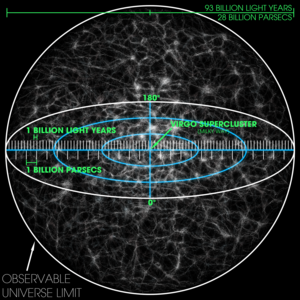Hubble volume

In cosmology, a Hubble volume, or Hubble sphere, is a spherical region of the Universe surrounding an observer beyond which objects recede from that observer at a rate greater than the speed of light due to the expansion of the Universe.[1] The Hubble volume is approximately 1031 cubic light years.[2]
The comoving radius of a Hubble sphere (known as the Hubble radius or the Hubble length) is , where is the speed of light and is the Hubble constant. The surface of a Hubble sphere is called the microphysical horizon,[3] the Hubble surface, or the Hubble limit.
More generally, the term "Hubble volume" can be applied to any region of space with a volume of order . However, the term is also frequently (but mistakenly) used as a synonym for the observable universe; the latter is larger than the Hubble volume.[4][5]
Relationship to age of the universe
The Hubble length is 14 billion light years in the standard cosmological model, somewhat larger than times the age of the universe, 13.8 billion years. This is because gives the age of the Universe by a backward extrapolation which assumes that the recession speed of each galaxy has been constant. However, modern observations indicate recession speeds are increasing slightly[6] due to dark energy, so that is only an approximation to the age of the universe.
Hubble limit as an event horizon
Objects at the Hubble limit have an average comoving speed of c relative to an observer on the Earth so that, in a universe with constant Hubble parameter, light emitted at the present time by objects outside the Hubble limit would never be seen by an observer on Earth. That is, Hubble limit would coincide with a cosmological event horizon (a boundary separating events visible at some time and those that are never visible[7]).
However, the Hubble parameter is not constant in various cosmological models[4] so that the Hubble limit does not, in general, coincide with a cosmological event horizon. For example in a decelerating Friedmann universe the Hubble sphere expands faster than the Universe and its boundary overtakes light emitted by receding galaxies so that light emitted at earlier times by objects outside the Hubble sphere still may eventually arrive inside the sphere and be seen by us.[4] Conversely, in an accelerating universe, the Hubble sphere expands more slowly than the Universe, and bodies move out of the Hubble sphere.[1]
Observations indicate that the Universe is accelerating,[6] so that some objects that we can currently exchange signals with will one day cross our Hubble limit.
See also
References
- ^ a b Edward Robert Harrison (2003). Masks of the Universe. Cambridge University Press. p. 206. ISBN 0-521-77351-2.
- ^ "The Size of the Universe". Retrieved 2 June 2014.
- ^ N. Carlevaro & G. Montani (2009). "Study of the Quasi-isotropic Solution near the Cosmological Singularity in Presence of Bulk-Viscosity". arXiv:0711.1952.
- ^ a b c For a discussion of why objects that are outside the Earth's Hubble sphere can be seen from Earth, see TM Davis & CH Linewater (2003). "Expanding Confusion: common misconceptions of cosmological horizons and the superluminal expansion of the universe". arXiv:astro-ph/0310808.
- ^ For an example of mistaken usage, see Max Tegmark (2004). "Parallel Universes". In Barrow, J. D.; Davies, J. D.; Harper, C. L. (eds.). Science and Ultimate Reality: From Quantum to Cosmos. Cambridge University Press. pp. 459ff. ISBN 0-521-83113-X.
- ^ a b John L Tonry; et al. (2003). "Cosmological Results from High-z Supernovae". Astrophys J. 594: 1. arXiv:astro-ph/0305008. Bibcode:2003ApJ...594....1T. doi:10.1086/376865.
{{cite journal}}: Unknown parameter|author-separator=ignored (help) - ^ Edward Robert Harrison (2000). Masks of the Universe. Cambridge University Press. p. 439. ISBN 0-521-66148-X.





